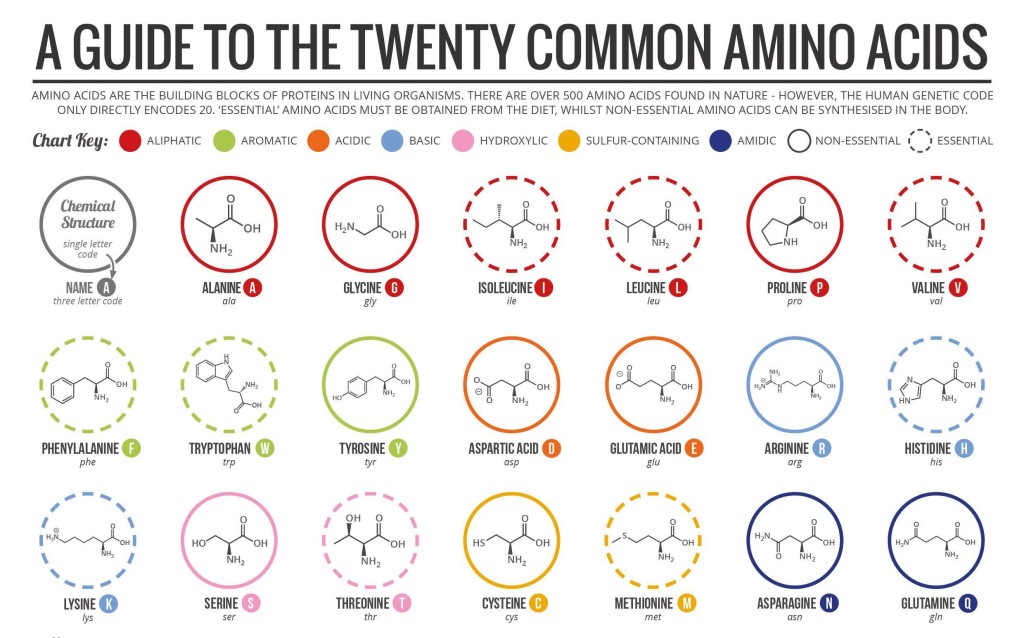When discussing health and fitness, we sometimes hear scientific terms that describe the body. But we might not always understand exactly what these terms mean. Ever wondered what amino acids are and why they are so important? Or what the difference between “essential” and “non-essential” amino acids are?
Amino acids can be called the “building blocks” of protein and are an important part of every human body. There are 20 different amino acids – nine of which are called “essential” and 11 of which are labeled as “non-essential.” The human body needs all 20 of these amino acids, in varying degrees, to be healthy and fully functional. All 20 have distinct chemical structures and are used for different roles – such as forming neurotransmitters, forming hormones and producing energy. But their primary role is to build proteins.
Protein is part of every single cell in the human body and is essential to the body’s functioning. Protein helps build and repair tissues like skin and muscle, and it helps produce antibodies and insulin. From only 20 amino acids, the body is able to generate many thousands of unique proteins with different functions. Each one of these proteins contains between 50 and 2000 amino acids, connected in varying sequences. After all of these amino acids are joined together, they are folded and twisted to make a specific shape. This unique shape is the determining factor for what the protein does for the body.
From only 9 essential and 11 non-essential amino acids, the body is able to generate many thousands of unique proteins with different functions.
So what is the difference between essential and non-essential amino acids? How do they work differently with the body and why is each type necessary?
Essential Amino Acids
First up are the essential amino acids. These are the nine amino acids that your body CANNOT create on its own, and that you must obtain by eating various foods. Adults need to eat foods that contain the following eight amino acids:
methionine, valine, tryptophan, isoleucine, leucine, lysine, threonine and phenylalanine. Histidine, the ninth amino acid, is only necessary for babies.
Instead of storing up a supply of the essential acids, the body uses them to create new proteins on a regular basis. Therefore, the body needs a continual – ideally daily – supply of these amino acids to stay healthy.
Non-Essential Amino Acids
The other type is the non-essential amino acid, 11 of which exist and are synthesized by the body. Thus, although they are an important part of building proteins, they do not need to be included in an everyday diet. Eight of these non-essential acids are also known as “conditional,” meaning that the body may not be capable of producing enough of them when presented with substantial stress or illness.
So now – the big question. How do we make sure that we are meeting our body’s amino acid requirements through our diet? The answer is surprisingly simple enough – all we have to do is eat a recommended amount of protein each day and consume a variety of whole foods. Animal proteins are called complete proteins because they naturally contain all nine essential amino acids in each serving. But what about those of us who don’t want to eat meat? What are our options?
Plant proteins, with the exception of quinoa and a few others, are naturally lower in some of the essential amino acids, and are therefore called incomplete proteins. However, by eating a diverse diet of vegetables, grains, and legumes, you can easily create complete proteins. Another great option is including a full-spectrum vegan protein powder in your diet. For example, try sprouted brown rice protein, which is naturally digestible, bioavailable and offers a complete spectrum of amino acids.
However you choose to nourish your body, make sure that your diet is rich in whole foods and plant life. In doing so, you can be sure that your body is receiving a full amino acid profile and is therefore primed to thrive.
Sources:
Sandi Busch, SF Gate, “Difference Between Essential & Non Essential Amino Acids”
